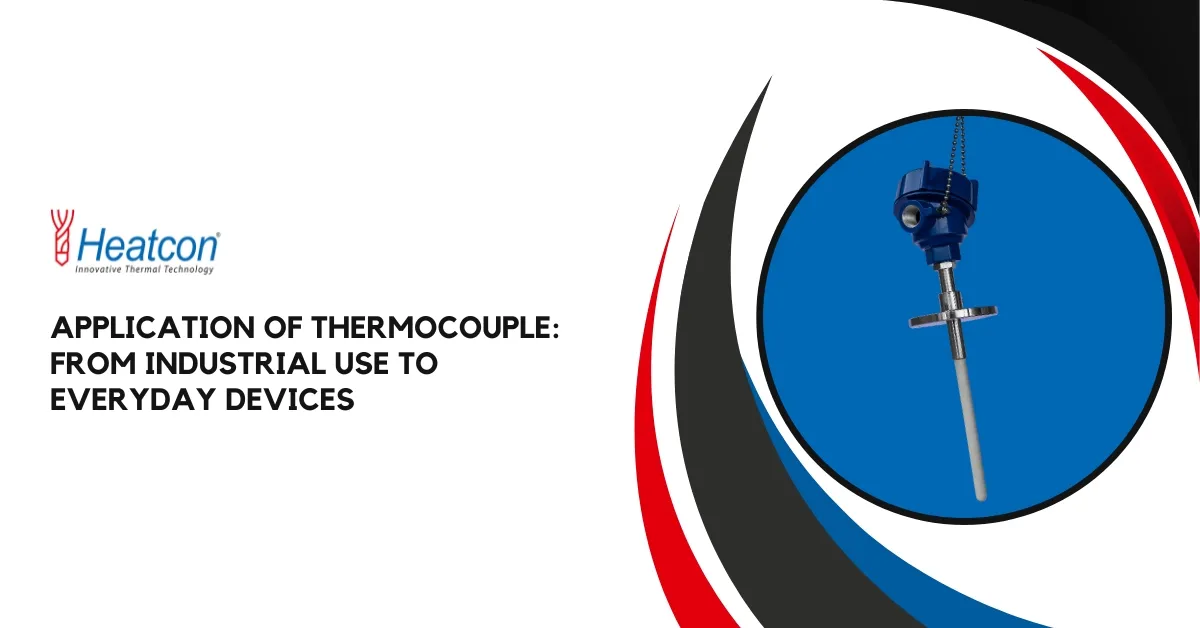Thermocouple Usage in Numbers: Versatile Tools in Temperature Measurement
Thermocouples tend to play a pivotal role in temperature measurements, with global demand estimated to grow by 5.4 percent yearly, reaching a market value of whopping US 2.72 billion dollars by the year 2027, as per Allied Market Research. This surge tends to emphasize their adaptability across a gamut of industries as well as everyday applications, making them indispensable in modern technology. Let us talk about the application of thermocouple.
Application of Thermocouple: From Industrial Use to Everyday Devices Used in Daily Lives
A thermocouple happens to be a temperature measurement device that is known for its reliability, accuracy, & versatility. Its working is based on the Seebeck effect, where a voltage tends to be generated at the junction of 2 distinct metals when exposed to temperature changes. This small yet powerful device finds applications in a number of domains, as follows:
- Industrial Applications: Thermocouples happen to be broadly utilised in a number of industries such as chemical plants, steel production, & power generation for monitoring extreme temperatures in furnaces, kilns, & reactors.
- Aerospace: Aerospace engineers tend to rely on thermocouples for monitoring turbine engine temperatures & for ensuring operational efficiency.
- Healthcare: Devices like MRI scanners & surgical equipment make use of thermocouples for precise thermal management.
- Food Processing: Ensuring food safety & quality is critical. Thermocouples help in maintaining the right temperatures while cooking, storage, & transportation.
Thermocouple Used in Daily Life
Devices such as thermocouple used in daily life include their integration into household appliances like water heaters, ovens, & HVAC systems. These sensors help ensure comfortable living conditions & energy efficiency by accurately regulating temperatures.
Uses of Thermocouple in the Industry
The uses of thermocouple in the industry are pretty vast, ranging from process control in petrochemical plants to monitoring cryogenic temperatures in the pharmaceutical sector. Their ability to operate in extreme & harsh conditions makes them indispensable for many industrial settings.
Thermocouple Working Principle
The thermocouple working principle revolves around the Seebeck effect. An electromotive force (EMF) is generated when 2 dissimilar metals are joined & exposed to different temperatures. The resulting voltage correlates with the temperature difference, allowing for precise measurements.
Thermocouple Advantages and Disadvantages
Understanding thermocouple advantages and disadvantages helps you select the right type for your specific industrial application.
Advantages:
- Quick response time.
- Durable & cost-efficient.
- Broad temperature range compatibility.
Disadvantages:
- Accuracy can be influenced by external conditions.
- Signals may require amplification for long-distance transmission.
K Type Thermocouple Working Principle
The K type thermocouple working principle also works on the Seebeck effect, combining nickel-chromium & nickel-aluminum alloys. Known for its sturdiness, the K type is suitable for temperatures ranging from -200 degrees Celsius to 1260 degrees Celsius, making it ideal for industrial processes & scientific research.
Construction of Thermocouple
The construction of thermocouple involves 2 dissimilar metal wires joined at one end (measuring junction) and connected to a reference junction. Insulation materials protect the wires, and the assembly is housed in a durable sheath, ensuring long-term performance in extreme environments.
What Is the Most Frequent Application of Thermocouple?
Thermocouples rank as the most prevalent temperature sensors worldwide, owing to their broad temperature range, durability, and affordability. These sensors find applications in various sectors, extending from household devices and industrial operations to electricity generation, furnace oversight and regulation, food and beverage manufacturing, automotive sensing, aircraft engines, as well as rockets, satellites, and spacecraft. In scenarios demanding elevated temperatures, compactness, quick response times, and resilience against vibrations or shocks, thermocouples often deliver essential temperature readings.
Thermocouples Used in the Food Industry
Thermocouples can serve numerous purposes within the food & beverage sector, including Clean-In-Place sensors, penetration probes, oven management, monitoring food supply chains, controlling & overseeing hotplates, and regulating steam kettles.
Thermocouples Used for Extrusion Processes
Extruders operate under conditions of high temperature and pressure. They utilize unique threaded adapters to accurately position the sensor tip within the molten plastic amidst these high-pressure environments.
Thermocouples Used for Low-Temperature Measurements
Type E, Type K, Type T, & Type N thermocouples can function effectively for temperature readings as low as -200°C; however, the alloys utilized in these thermocouples must be meticulously chosen for these low-temperature applications to achieve the specified accuracies. The majority of thermocouple manufacturers procure their thermocouple alloys calibrated for use from 0°C and above. Although these alloys can perform down to -200°C, their accuracy may slightly vary from standard values. Custom calibrations can be obtained to establish any offset values.
Thermocouples Used for Furnace Operations
The specific conditions that a thermocouple will confront in a furnace will dictate the appropriate type for the task. Essential factors to consider in the selection process include:
- The configuration for mounting.
- The temperature tolerances of the thermocouple wires.
- The surrounding atmosphere (air, reducing, oxidizing, inert).
- The temperature tolerances of the protective sheath (metal or ceramic).
Thermocouples Used for Measuring Molten Metal
Determining the temperature of molten metal poses significant challenges due to extreme temperatures and harsh conditions present. For contact measurements in this domain, Type K & Type N Base Metal thermocouples, along with Types R, Type S, & Type B Platinum thermocouples, are the recommended options. When these base metal thermocouples are employed, they typically feature larger diameter wires, such as #8 or #14 AWG solid wires with ceramic insulators & ceramic or metal protective tubing. The increased diameter of Type K or Type N wires ensures slower degradation, allowing ample time for temperature measurements before extreme conditions affect the wires. Platinum thermocouple wires are usually around #20 to #30 AWG solid. In contrast to the degradation seen in base metal Type K & Type N wires, the platinum wires do not succumb to oxidation or corrosion; instead, they soften over extended periods of annealing and ultimately fail due to grain growth.
Obtain the Best Thermocouples from Heatcon Sensors
If you are in search of top-quality sensors for your specific industrial application of thermocouple, Heatcon Sensors is a reliable option. Our knowledge in creating dependable & efficient temperature measurement solutions guarantees optimal performance for various applications. Whether you need custom creations or standard industry models like K type thermocouples, Heatcon Sensors tends to offer unparalleled quality & assistance. Check out our vast selection to discover the ideal solution for your temperature measurement requirements. Thermocouple remains a crucial sensor, connecting industrial needs with everyday convenience. Opt for Heatcon Sensors for innovation & accuracy in thermocouple solutions.


